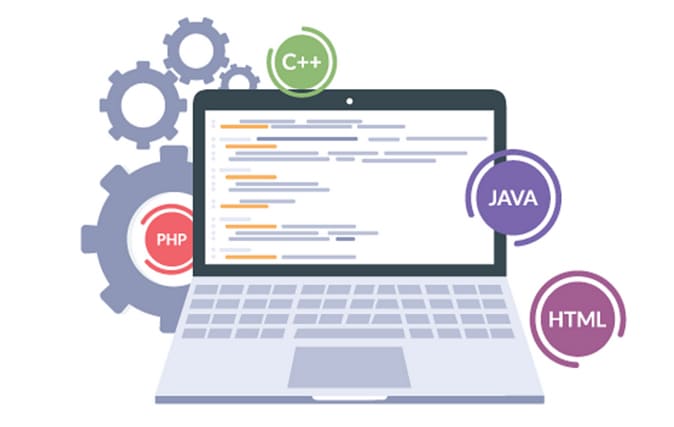
Web Development Frameworks: Today, I’ll look at the top 10 web development frameworks for 2024. Web development frameworks have become essential in modern web development if you’re looking to secure a job as a web developer, improve your portfolio, or enhance your skills. So, what exactly is a web development framework? If you’re starting, there’s no need to stress. Before we discuss the top 10 web development frameworks, let’s introduce the concept of a web development framework.
If you’re pressed for time, here’s a quick summary: A web development framework is a collection of tools and pre-written code that aids developers in building and managing websites with greater efficiency. In a nutshell, they’re unique and perfect for web developers like us! In addition, according to the Bureau of Labor Statistics, web developers can earn an average salary of over $85K. Familiarizing yourself with web development frameworks can lead to a fulfilling career.
Alright, let’s get started exploring these web development frameworks. To organize our list, we’ll separate it into front-end and back-end frameworks. Let’s get moving!
What Is A Web Development Framework?
If you’re starting in web development or have recently completed a web development course, this is the perfect place to begin!
Let’s begin with the fundamentals: what is a web development framework? Web development frameworks are software frameworks that help create websites, web apps, web services, web APIs, and web resources. Our goal is to simplify the process of building and deploying web apps by automating common web development tasks.
Is everything clear? Is it somewhat? Alright, can you explain it to me like I’m five? Does that make sense? Kind of? Okay, how about ELI5?
Starting from scratch is not ideal. Why bother digging clay for bricks or cutting down trees for wood? It’s more logical to begin with a kit that includes all the essential components, such as bricks, wood, and glass. This kit functions similarly to a web development framework. A web development framework provides the essential components for building a website or app, saving you the trouble of starting from scratch.
These code snippets are ready-made and perform common functions essential for most websites, such as displaying images or enabling user login. It’s similar to constructing with blocks, each representing a unique piece of code. Combining these blocks allows you to build your website effortlessly, saving you time and effort compared to manually creating each block in your preferred web development IDE.
In addition, since numerous individuals use similar frameworks, it’s akin to having friends assist you in constructing your house. They can offer guidance and support if you encounter any difficulties. In simple terms, a web development framework can be compared to a collection of building blocks used to create websites. It simplifies tasks and speeds up the process, with plenty of friends available to assist you!
Features of Web Development Framework
Now, we will examine critical aspects of these web development tools:
Pre-written Code: Frameworks offer a convenient structure for web applications, saving you from starting from scratch. They come with built-in functions for data management and displaying it on web pages.
Libraries and Tools: They typically include libraries for database access, templating frameworks, and session management, and they frequently encourage code reuse.
Security Features: Frameworks also provide security features to safeguard against threats like SQL injection, cross-site scripting (XSS), and more.
Increased Efficiency and Speed: Frameworks can expedite the development process by implementing a structured environment, resulting in improved efficiency.
MVC Architecture: Many frameworks organize their architecture using the MVC pattern. This pattern separates the data model, user interface, and user input into three distinct components.
Community and Support: Many web development frameworks benefit from robust communities and extensive support. They also offer a wide range of documentation, forums, and third-party tools.
Awesome. Now that we have covered the fundamentals let’s explore the top web frameworks for 2024. Let’s break it down into two perspectives: back-end and front-end.
Top 10 Best Web Development Framework
Let’s dive right into the top frameworks for backend web development. If you’re searching for a simple coding language, we have a variety of options. Whether it’s the ease of Node.js, the speed of Python, or the simplicity of Ruby, we have you covered. Alternatively, if you prefer PHP’s clean syntax or Java’s reliable enterprise-grade features, that works too! I’ve included a variety of web development frameworks with different strengths and advantages. This way, no matter which one you choose, you’ll be well-prepared to create robust, scalable, and efficient server-side applications.
1. Express
Ideal for rapidly developing web applications and RESTful APIs using Node.js. Let’s kick things off with Express.js! This Node.js web application framework offers a wide range of web and mobile application features while keeping things simple and easy to understand. I appreciate how efficient Express.js is for building server-side applications, especially when creating RESTful APIs. Its simple design enables fast and effortless server setup, making it a popular choice among Node.js developers.
I appreciate the simplicity of Express.js, along with its robust routing and middleware features. Additionally, it is unbiased, making it ideal for those who prefer complete control over their applications. Express is great for creating intricate features with minimal code and increased adaptability. Express.js middleware simplifies the processing of requests and responses, making it effortless to implement features such as parsing incoming requests or setting up cookies.
Express.js allows for flexible structuring of applications without strict conventions. This flexibility is especially beneficial for projects that need a personalized setup or integration with other tools and libraries. In addition, you can enjoy the flexibility of using other frameworks, such as Socket.io, to create real-time web applications. Express.js is known for its lightweight nature and seamless integration with databases like MongoDB, making it an excellent choice for developing fast and scalable network applications. It is also included in the MEAN and MERN stacks, which are widely used for full-stack development. If you’re a web developer looking to explore backend development with JavaScript, Express is a great option.
Website: https://expressjs.com
2. Next.js
It is ideal for creating server-rendered React applications that offer enhanced SEO and performance. Look at Next.js, a framework that makes building modern web applications a breeze. It’s trendy for its smooth integration with React. It offers excellent support for server-side rendering (SSR) and static site generation (SSG), which greatly enhance web applications’ performance and SEO.
Next.js is an excellent option for projects prioritizing search engine visibility and fast load times. Next.js builds on React’s strength and adds features like automatic code splitting to improve page load times by loading only the necessary JavaScript for the current view. This leads to a streamlined and optimized user experience.
This JS framework is designed with simplicity in mind. Its setup requires no configuration and allows developers to start working quickly. Next.js is user-friendly for beginners while also offering advanced capabilities for complex enterprise applications. Next.js has a vibrant ecosystem and a strong community behind it. With built-in CSS and Sass support, API routes for creating API endpoints, and various plugins and integrations, Next.js offers a comprehensive solution for full-stack development.
No matter the size or complexity of your website, Next.js provides a scalable, high-performing, and enjoyable development experience. If you’re a developer who wants to take advantage of React’s power and create real-world web applications with enhanced capabilities, Next.js is a fantastic option to explore.
Website: https://nextjs.org
3. Django
It is ideal for quickly building strong and scalable web applications that rely on data, and it includes a broad range of features. Now, it’s up to personal preference whether you agree with my choice of Django over Flask! Both options are equally good, so let’s avoid any unnecessary arguments! Moreover, if renowned companies like Instagram have embraced it, it must be exceptional!
Django is a Python web framework that promotes quick development and practical design. I appreciate Django’s comprehensive set of features, which are essential for web development and align with its “batteries-included” philosophy. I like how Django focuses on automating tasks to make things easier.
This is evident through its strong Object-Relational Mapping (ORM) layer, which streamlines database interactions, and its reliable migration system for smoothly updating your database schema. The built-in admin interface in Django is also a standout feature. This can be a game-changer for developers. It offers a user-friendly interface for managing your site’s data. It is a valuable tool for quickly creating prototypes and a helpful asset for non-technical users to handle site content.
Django is well-known for its strong security features. It is designed to prevent common security mistakes and automatically protect websites, which benefits developers like us. Indeed, this ensures you are safeguarded against CSRF, SQL injection, and XSS, making it a reliable option for projects prioritizing security.
Django’s template engine, URL routing, and authentication mechanisms are designed to speed up and simplify web development. These features and Django’s commitment to the DRY principle enhance development speed while maintaining code quality. Due to its scalability and versatility, this web development framework is widely used for both small projects and large, high-traffic sites such as Instagram and Pinterest. In addition, the community surrounding it is robust, and numerous third-party packages are available, allowing you to easily customize it to meet the needs of any project. Django is definitely worth considering if you’ve recently completed a Python course and are interested in web development.
Website: https://www.djangoproject.com
4. Laravel
Ideal for quickly developing contemporary full-stack web applications using PHP. Laravel is a popular PHP framework highly regarded for its clean syntax and powerful features. It is a top choice for web application development in 2024.
One thing that caught my attention was how Laravel is highly regarded for its knack for streamlining common tasks in PHP projects. It simplifies tasks such as authentication, routing, sessions, and caching. Laravel stands out with its elegant and expressive syntax, which aims to make the development process easier and more enjoyable.
I can confirm that Laravel is highly effective in simplifying development by streamlining common tasks, greatly benefiting developers. Laravel’s Eloquent ORM is a standout feature. This sophisticated implementation of the active record pattern makes it incredibly simple to interact with database objects and relationships using a clear and intuitive syntax. Laravel also includes a lightweight templating engine called Blade. It is user-friendly and allows for creating impressive layouts using control structures. This is designed to work seamlessly with typical PHP code and offers a range of benefits, including template inheritance and data formatting.
Another aspect I appreciate about Laravel is its focus on testing. That’s because it’s seamlessly integrated with PHPUnit for unit testing and offers a variety of helpful methods that make testing applications a breeze. We prioritize testing to ensure that your application is free from bugs. I’m on board with that! This web development framework has various tools and features to assist with tasks such as queues, real-time events, and scheduled jobs. This makes it ideal for creating modern, real-time web applications. If you’ve recently completed a PHP course and want to showcase your web development skills, I recommend exploring Laravel.
Website: https://laravel.com
5. Spring
Ideal for developing intricate, high-level applications and microservices using Java. Now, let’s explore the widely used Java framework called Spring to complete our list of back-end frameworks. If you need to get more familiar, Spring is a compelling and flexible open-source application framework for the Java platform.
In addition, Java is compatible with multiple platforms. One of its notable features is dependency injection. Although it may seem complex, it’s a simple design pattern. In this pattern, objects rely on an external source (such as the Spring Framework) to provide their dependencies rather than creating them themselves.
The goal is to create modular, testable, and easy-to-maintain code.
The main focus of the Spring framework is to simplify and streamline Java enterprise development. Doesn’t it sound great? What I find impressive about Spring is its extensive infrastructure support for building strong Java applications. It simplifies Java EE development, making it easier for newer Java developers who have recently completed a Java course. Spring achieves this through its inversion of control (IoC) container, which efficiently manages Java objects known as beans using dependency injection.
I understand that there may be a lot of terminology involved, but it’s pretty straightforward. IoC refers to the framework managing object creation and life cycle rather than the objects handling their creation and dependencies.
The objective is to encourage loose coupling and flexibility in the application’s architecture. Spring’s modularity is a significant advantage. Spring offers a variety of sub-frameworks that can be used independently or together, depending on the requirements of your Java project. You can use Spring MVC for web applications, while Spring Boot is suitable for microservices. Additionally, Spring Data provides convenient data access capabilities. This flexibility allows for easy integration into your project.
It’s worth noting that Spring is highly flexible. Spring also offers support for aspect-oriented programming (AOP), separating cross-cutting concerns such as logging and security from the business logic. This is great because it improves code cleanliness and enhances maintainability and scalability.
It’s worth noting that Spring Boot, a project in the Spring ecosystem, makes it easier to set up and develop new Spring applications. It offers a variety of pre-configured setups and conventions, so you can quickly and easily run a fully functional application.
Website: https://spring.io
6. Rails
Ideal for quickly building top-notch, easy-to-maintain web applications using Ruby. Rails, also called Ruby on Rails, is a highly efficient and widely used web application framework built with Ruby. It is recognized for its philosophy of prioritizing convention over configuration and its principle of avoiding repetition, simplifying the development process.
I am fond of Rails because it was a key component of my final year project in college. What I find remarkable about Rails is its ability to streamline and accelerate web application development. This is mainly due to a comprehensive set of conventions and defaults that eliminate the need for unnecessary code. Rails enables you to quickly launch an application, allowing you to concentrate on the distinctive elements of your project without any unnecessary complications.
GitHub, Airbnb, Hulu, and Microsoft all choose to include Rails in their tech stacks.
Rails is well-known for its comprehensive approach, encompassing both front-end and back-end development. This covers all aspects, from the presentation layer (HTML, CSS, JavaScript) to the interactions with the database. With Rails, you can easily create a complete application without the hassle of dealing with various frameworks or languages. I appreciate its simplicity and readability. Concentrating on one framework ecosystem instead of piecing together various libraries and frameworks is incredibly useful.
Rails offers a convenient active record ORM that streamlines database interactions. It becomes simpler to create, retrieve, update, and delete database records without the need for SQL queries, resulting in code that is easier to read and maintain. Rails has a thriving community that offers a multitude of benefits. Additionally, a wide range of gems are available that can enhance the functionality of your Rails applications. For some reason, ever since the Marvel movies, Rails’ gems have always reminded me of infinity stones!
In any case, the strong community support and a wide range of libraries and plugins make Rails a highly effective tool for efficiently building complex web applications. Rails also prioritizes testing and includes a built-in testing framework that promotes test-driven development (TDD) from the start. I love the emphasis on TDD because it allows me to create more reliable and bug-free applications. If you’re new to TDD, I recommend trying it! Rails is a great framework for web development, whether you’re new or have experience. It’s user-friendly and efficient, making it a popular choice for developers.
Website: https://rubyonrails.org
7. Angular
Ideal for creating robust applications for big projects with top-notch performance and tailored to enterprise needs. Let’s start with Angular. This web application, developed by Google, is widely used by tech giants such as PayPal. It is known for its power and open-source nature. Angular is a popular JavaScript framework that is great for building efficient and sophisticated single-page applications (SPAs).
Angularjs is known for its extensive features, such as two-way data binding, form handling, routing, and dependency injection. These features make development more accessible and increase productivity. Angular offers a comprehensive framework that goes beyond just the view layer. It includes various tools for testing, developing, and deploying applications.
I also appreciate that it uses TypeScript for consistent code, improved readability, and strong type-checking. Indeed, learning TypeScript may require some initial effort, but fret not! There are numerous excellent TypeScript courses tailored specifically for beginners like yourself. The security advantages are worth it, mainly if you’re involved in a sizable JavaScript project and considering transitioning to TypeScript.
Angular’s architecture is designed to be component-based, which makes it easy to reuse code and promotes efficient development practices. This framework is highly preferred for enterprise-scale applications because of its ability to scale, maintainability, and focus on testing and best coding practices. Due to its many advantages, numerous excellent Angular courses are available for those looking to learn how to use this JavaScript framework.
Website: https://angular.io
8. React
Ideal for creating dynamic and interactive user interfaces for web and mobile applications. React is a JavaScript library and not a framework; there is no need to remind me. However, this distinction is insignificant for most web developers. React is widely regarded as one of the most popular JavaScript frameworks, and it is a popular choice for tech giants like Uber! It’s one of my preferred web development libraries, so I like it! If you started with HTML, CSS, and AJAX code for web development before JavaScript and JS frameworks became popular, you’ll see why I enjoy it so much! React is great for creating user interfaces and is highly regarded for its efficiency and flexibility in building interactive and complex web applications.
Created by Facebook, React is designed to simplify building reusable components that handle state management. This approach results in code that is more predictable and easier to debug. I also like to use TypeScript for added security when working on React projects. It uses a virtual DOM to enhance performance by selectively updating specific page parts instead of refreshing the entire view. React is well-suited for applications that require frequent user interaction. React can be easily combined with other libraries, such as Redux, for state management, making it a flexible option for front-end development. The community highly supports React, has a wide range of resources available, and is widely used by web developers worldwide. With its immense popularity, there is a wide array of excellent React courses to help you master its usage.
Website: https://reactjs.org
9. Vue
Perfect for building flexible user interfaces and single-page applications that are easy to learn. Vue.js is a popular JavaScript framework known for its simplicity and flexibility. It is commonly used for creating user interfaces and single-page applications. Vue is designed to be easily integrated into developers’ existing projects, allowing for a gradual adoption. I appreciate this feature as it will enable users to try out Vue and gauge their interest before fully committing to it for development.
That said, you can use it to construct intricate applications from scratch if you like! Vue’s core library prioritizes the view layer, allowing for seamless integration with other libraries or existing projects. It is also suitable for advanced SPAs when used with complementary libraries. If you’re interested in Vue.js, consider taking a Vue.js course. The data binding and reactive components provide a simple and efficient method for managing the application state and creating dynamic user interfaces. Vue provides a diverse ecosystem that includes Vue Router for routing, Vuex for state management, and Vue CLI for project scaffolding. This solution is perfect for developers who want a balance between performance, flexibility, and ease of use. It’s comprehensive and easy to use.
Website: https://vuejs.org
10. Svelte
It is perfect for quickly and easily building responsive web apps without the need for excessive code or manual DOM manipulation. Svelte is a fresh JavaScript framework that catches attention with its distinct approach and efficiency, especially in creating responsive user interfaces and single-page applications (SPAs). What makes Svelte genuinely unique is its impressive compile-time magic. Svelte takes a different approach from other frameworks. Instead of using a virtual DOM, it optimizes the JavaScript code during the compile stage to update the browser’s DOM efficiently.
This leads to quicker runtime performance and reduced code bloat, resulting in cleaner and more efficient applications. Developers will find this experience to be delightful and streamlined. With Svelte, you’ll write less code because it’s designed to understand the minimum of JavaScript required to build your app. This results in codebases that are easier to read and maintain, particularly for intricate projects. Svelte’s syntax is simple and intuitive, making it accessible to anyone with HTML, CSS, and JavaScript knowledge. It’s incredibly user-friendly for creating dynamic user interfaces, making reactivity and state management a breeze.
In addition, Svelte provides a thriving ecosystem that includes SvelteKit for creating server-side rendered applications and a range of community-contributed libraries and tools. This product’s increasing popularity demonstrates its ability to effectively balance performance, simplicity, and developer experience. If you’re interested in a framework that challenges the traditional approach and provides a more streamlined way to build web applications, you should check out Svelte. It’s an excellent option for individuals looking for a contemporary and efficient method.
Website: https://svelte.dev
Concluding: Top Web Development Frameworks
Here are the top 10 web development frameworks for 2024. Web development frameworks are a great tool for staying ahead in modern web development. They can help you land a job as a web developer, improve your portfolio, and enhance your skills. Whether you’re a beginner or not, I hope you now have a clearer understanding of web development frameworks and their benefits. Which option do you prefer? Are there any additional frameworks you want us to consider for our web development list? Please leave your thoughts in the comments section.



